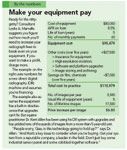X marks the spot
You've bought new digital radiography equipment. Now where will your fees land? Will you just break even or make a profit?
YOU'RE FINALLY SOLD ON DIGITAL radiography. No more waiting for film to develop to see whether you got the shot: You get results in less than a minute with cassette-based computed radiography (CR) and in an instant with direct digital radiography (DR). No more storage room full of radiographs: They're on CDs or the in-house server, or in off-site digital storage.

Make your equipment pay
You know you're in good company; everybody's doing it. Two leading makers of digital radiography equipment estimated that they receive 25 percent and 35 percent, respectively, of their business from equine practitioners.
So once you buy the equipment—no less than $30,000 for CR or $80,000 for DR—what will you charge for these faster, higher-quality results? It'll be more than film-based radiographs, but how much more? Will you aim to break even or make a profit?
Check out this advice from a veterinarian and veterinary consultants and make up your mind.
Be cool with charges
You didn't get into this business solely to make money. But still, you need to think about the value of your work and the benefits of this new technology, says Elise Lacher, CPA, a veterinary consultant at Lacher McDonald Consulting in Seminole, Fla.
The key is to be comfortable with the fee so you don't hesitate to offer the service and you charge for it with confidence. Lacher uses the example of dental work. Say you typically charge $100 for a set of film-based radiographs and $75 for an oral exam. A set of digital radiographs might be well-priced at $150 or more, but you're hesitant to charge that. Make it up in the exam—a $75 exam may run $125 because you've got a better picture. Resulting procedures like a float could easily run $75 to $100 more than a float performed without good radiographs.
However you work it out in your head, remember that digital radiography helps you do a better job of diagnosing and treating, which in turn adds value for your clients.
But how much?
Those of you who mostly do prepurchase exams at racetrack practices generally can't charge more than your competitors. But that shouldn't keep you from making money from your investment in digital radiography. Dr. Kent Allen, owner of Virginia Equine Imaging in Middleburg, Va., does. He owned the first DR machine in equine practice back in 2001, and it's still going strong. He saw a 20 percent increase in radiographic exams in the first year and worked out package deals that benefited him, his patients, and his clients.
"We were charging $40 per digital radiograph, and with prepurchase exams you obviously take a lot," Dr. Allen says. "We didn't want to send clients into sticker shock."
Dr. Allen calculated the cost of 32 views—$1,280—and charged $800 for a package. Before he offered that discount, clients always wanted to pick and choose which film-based views they thought they needed. No more.
"We shoot our standard group of radiographs, and if we need more, we just shoot them," Dr. Allen says. "It costs us nothing more than our time, so we don't have to charge more."
Dr. Allen's clients also receive free CDs with the radiographs, although some equine practitioners charge for burning them onto CDs.
Health at any cost
Fees are different when it comes to wellness care, according to Lacher. "Outside of prepurchase exams, clients aren't shopping for radiograph costs," she says. "Think about it this way: Do you ever call three or four dentists to find out the cost of X-rays?"
Horse owners understand that it's more expensive to own a horse than a small animal, says Leslie A. Mamalis, MBA, MSIT (master of science in information technology), of Summit Veterinary Advisors in Littleton, Colo. "If clients aren't complaining at all about any of your fees, you're probably not charging enough," she says.
Mamalis often counsels veterinarians to double radiograph fees when they switch from film-based to digital technology. (So if you were charging $15 per view, now you'd charge $30.) But, she says, many veterinarians opt only for a 50 percent increase.
Her concern: You face higher costs with the move to digital radiography. For example, you need digital storage and high-resolution monitors. Monitors approved for human radiography and recommended by many board-certified veterinary radiologists run $8,000 to $10,000 or more.
Of course, you may not need to bulk up on additional monitors and off-site storage all at once. "I didn't grasp all I needed for storage when we started using the equipment," Dr. Allen says. "Now we've got a terabyte-sized image server that uploads the images to a digital vault off-site. At the start, we were just storing on CDs in the back room."
On the flip side, you'll see savings when you don't pay film-processing costs or buy chemicals, and the ease of use encourages team members to take more and better radiographs.
It's all about image
Money issues aside, Dr. Allen says digital radiography's stellar image quality makes it essential to any equine practice. "Pay an extra $10,000 for the best equipment from a reputable company," Dr. Allen says. "Sit down in front of the monitor with the client. They love being involved in the process. If you do that, they don't mind paying more."